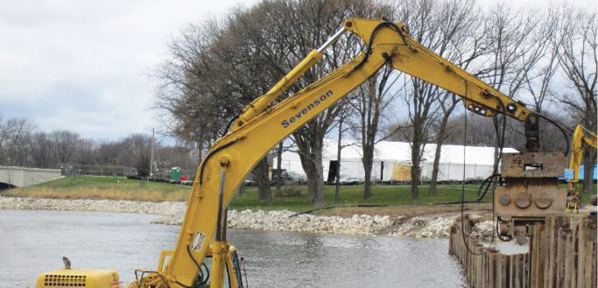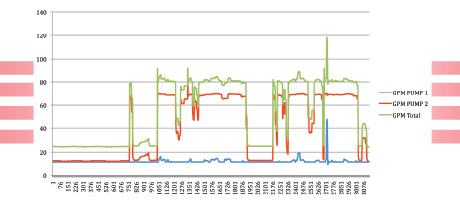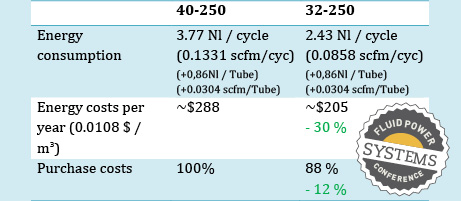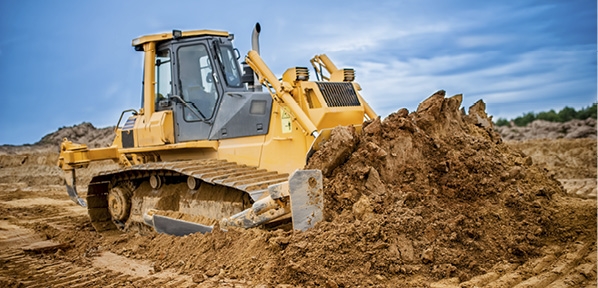Saving Cost, Weight, and Space on Trucks

By Björn Arvidsson, Product Development Engineer, Alexander Hahn, Sales Director – Systems, and Jussi Ijäs, Sales Director – Components, PMC Hydraulics
Reduction is a key focus for new trucks, cranes, construction vehicles, and other mobile hydraulics. The way forward is to add innovative technology solutions that reduce weight and increase the maximum payload. The goal is also to reduce fuel consumption and maintenance costs to improve the efficiency and bottom line profit.
The hydraulic industry is constantly developing innovative technology for trucks. One example of an innovative idea is the cyclone tank that enforces the separation of air. It started with hydraulic driven fan drives on buses in 1999, and today the focus has expanded to trucks and other mobile machines. With these machines in mind, the cyclone tank can reduce the amount of hydraulic oil by 50 to 90%.

A cyclone insert inside the tank separates the air from the oil. The cyclone continues to work as long as it is covered by oil. An important innovation in this cyclone tank is that it has a variable inlet. This keeps the velocity of the hydraulic fluid constant and separation of air is therefore equally forced irrespective of flow. The cyclone also creates some positive pressure in the inlet line due to the high speed of the oil that enters the inlet line. This positive pressure can reach 2 psi in favorable conditions.
The tank is designed to handle the normal volume difference in the system with some margin.

For cold starts, a system with the cyclone tank can reduce air and heat up the circulating oil fast. The pump gets a positive pressure in the inlet ports almost immediately. Several thousand buses, trucks, drill rigs, and other mobile machines have this technology today.
The cyclone tank has become more common on trucks with loader cranes. The crane can operate at maximum extension with almost an entirely different volume of the tank being used. Some cyclone tanks are mounted directly on the crane frame to reduce the need for space on the side of the truck.
Another benefit with cyclone tanks mounted directly on the crane is that the time for design and assembly of a new truck with a crane can be reduced. Sometimes trucks have an extra front axle or other equipment, and the space left for diesel tanks, hydraulic tanks, and boxes for lifting tools can be very limited. In the near future, we might need to add space for batteries on trucks with electric drive motors.
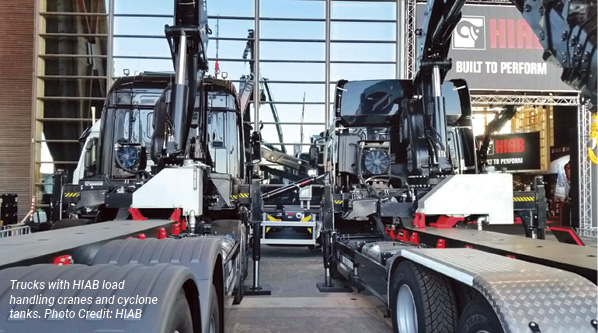
A cyclone tank can also be mounted on the side of the truck. These tanks are often used for timber trucks with cranes and for trucks handling waste material. A rugged cyclone tank in stainless steel can reduce the oil volume on a timber truck from 70 gallons to below 25 gallons of oil. In this application, the cyclone tank must be able to handle fast loading and unloading in both cold winter and hot summer conditions often without any cooler. The reduction of weight means that more load can be carried, and the fuel consumption will go down. The timber cranes are normally using variable axial piston pumps with maximum flow reaching up to 50 gpm.
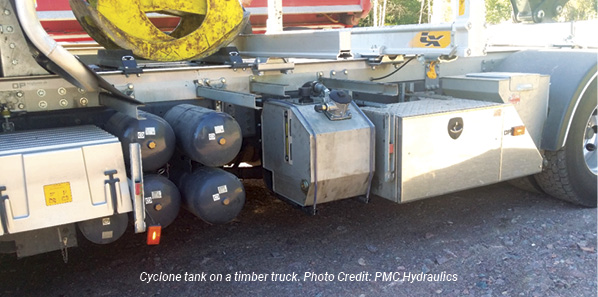
The cyclone tank for this application must handle very fast acceleration of oil in the suction lines without creating any cavitation. Calculations made by loader crane producer HIAB shows that a normal truck handling goods with a crane can save US$4,000 and 6,000 lbs. of CO2 over a 5-year period when equipped with a smaller cyclone tank. These reductions in cost and emissions are created by a reduced need for diesel and less hydraulic oil to replenish at normal driving of 60,000 miles per year.
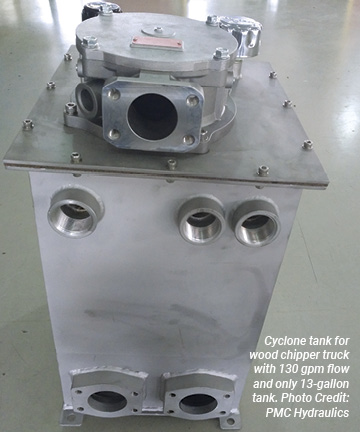 For truck applications with mainly hydraulic motor drives, the flow capacity can be 10 times higher than the oil volume. Sewer cleaner trucks and wood chipping trucks are two examples with very high pump flows compared to the volume of the cyclone tank needed. A truck with a wood chipper can have several pumps connected to one common suction chamber on the cyclone outlet. There are applications with several cyclones in one tank connected to one big suction chamber and several pumps as well. A standard 13-gallon tank can handle volume variations from cylinders of 8 gallons during operation.
For truck applications with mainly hydraulic motor drives, the flow capacity can be 10 times higher than the oil volume. Sewer cleaner trucks and wood chipping trucks are two examples with very high pump flows compared to the volume of the cyclone tank needed. A truck with a wood chipper can have several pumps connected to one common suction chamber on the cyclone outlet. There are applications with several cyclones in one tank connected to one big suction chamber and several pumps as well. A standard 13-gallon tank can handle volume variations from cylinders of 8 gallons during operation.
Another example are trucks that are painting lines and markings on roads. A small 8-gallon cyclone tank is enough for an 80 gpm pump flow. These types of small tanks can be positioned behind the driver cabin, and a small tank with less weight means more paint can be carried on the truck.
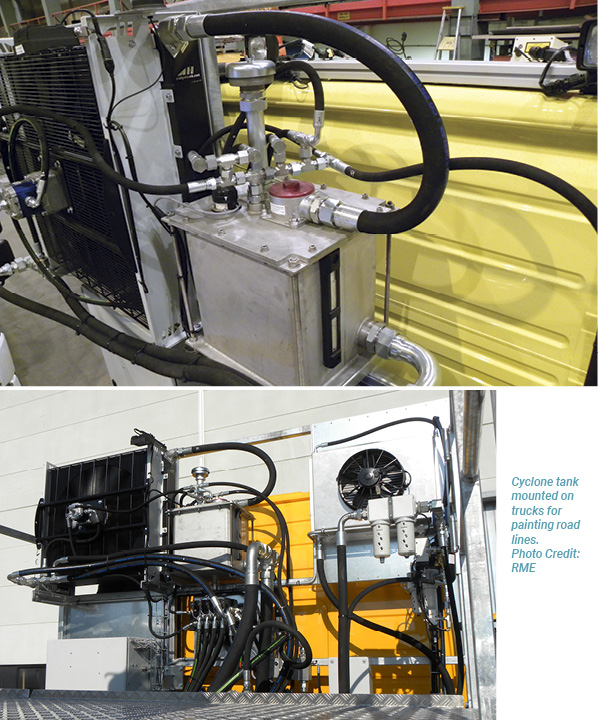
Another way to save cost and energy on trucks is to reduce the weight and pressure drop of valves. Cost-effective poppet valves can be one solution that can be integrated in narrow spaces. One example is unloading valves for trucks with fixed displacement pumps. These manifolds create a very low pressure drop in an unloaded position. The technology is also used for soft switch reversing of hydraulic fan drives on loaders in a small manifold with low pressure drop. The poppets can also be used in flow control manifolds for distributing oil with low pressure drop to hydraulic functions. Another example is cost effective control of cylinders on machines that recycles waste. A new application are battery driven machines. In these applications the poppet manifold is made with very low pressure drop because saving energy is a main concern.
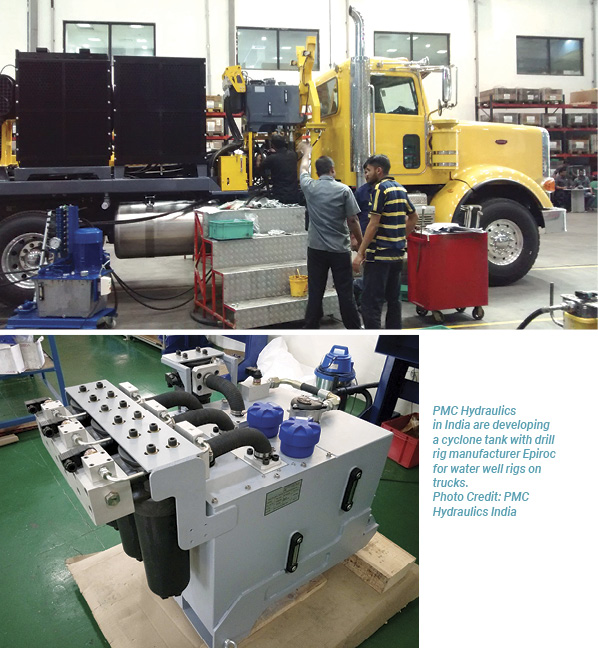
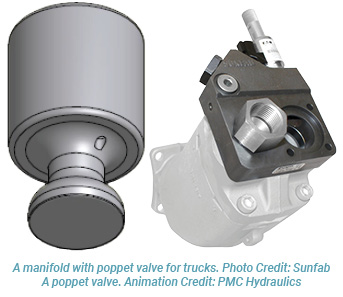 The poppet can be operated proportionally. One example is the main manifold on the boom of harvesters in forestry applications. Small manifolds are capable of 100+ gpm flow control function and pressure regulating functions with limited weight. Drill rigs are another segment that can benefit from the combination of poppet valves and cyclone tanks to create efficient systems that meet future demands.
The poppet can be operated proportionally. One example is the main manifold on the boom of harvesters in forestry applications. Small manifolds are capable of 100+ gpm flow control function and pressure regulating functions with limited weight. Drill rigs are another segment that can benefit from the combination of poppet valves and cyclone tanks to create efficient systems that meet future demands.
This technology can be an alternative to traditional load sensing hydraulics. Only the energy required to drive the hydraulics is used and all pressure drops in valves are kept to an absolute minimum. This requires more electronic control over the system, but it can be a way of reaching even higher efficiency in trucks and mobile hydraulics.



